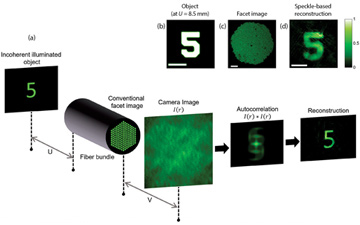 (a) Principle and (b to d) experimental demonstration. Conventional imaging of an object (b) through a fiber bundle (for U = 8.5 mm) yields no information on the object (c), but the speckle-based reconstruction (d) retrieves the original image (scalebars: 100 µm).
(a) Principle and (b to d) experimental demonstration. Conventional imaging of an object (b) through a fiber bundle (for U = 8.5 mm) yields no information on the object (c), but the speckle-based reconstruction (d) retrieves the original image (scalebars: 100 µm).
Flexible fiber optic endoscopes can image at depths beyond the reach of conventional microscopes. Current endoscopes require focusing or scanning mechanisms at the distal end, which limit miniaturization, frame rate and field of view. Alternative solutions, based on wavefront shaping, are lensless but are sensitive to fiber bending. Recently, researchers from Israel and France have exploited speckle correlations in multicore fibers to perform bend-insensitive, single-shot imaging at various working distances through conventional multicore fibers, without the use of distal optics or wavefront-shaping devices.1
Due to phase randomization between the different cores in a multicore fiber, the light from any point source placed at a distance U from the bundle input facet (the object plane) produces a speckle pattern at a distance V from the bundle output facet (see figure). This prevents direct imaging of objects placed at a distance from the fiber facet. However, while the speckle pattern from each point on the object is random, nearby points produce highly correlated, shifted speckle patterns.
As a result, an incoherently illuminated target will produce a seemingly random intensity pattern, which will be the intensity sum of these identical shifted speckle patterns. Building on recent breakthroughs in imaging through opaque barriers using angular speckle correlations,2 also known as the memory effect,3 it is possible to computationally recover the image of the object itself from the autocorrelation of a single camera image of this pattern. In essence, because of speckle correlations, the autocorrelation of the output image provides an estimate of the object’s autocorrelation, from which the object image is reconstructed through phase retrieval.
Our lensless technique can image planar objects placed at arbitrary working distances in either reflection or transmission geometry, with the field of view limited by the angular correlation range—which, for an ideal fiber bundle, is essentially the core’s numerical aperture.1
Researchers
Amir Porat and Ori Katz, Hebrew University of Jerusalem, Israel, and Laboratoire Kastler Brossel, Université Pierre et Marie Curie, Ecole Normale Supérieure, CNRS, Collège de France, Paris, France
Esben Ravn Andresen and Hervé Rigneault, Aix-Marseille Université, CNRS, Institut Fresnel, Marseille, France
Dan Oron, Weizmann Institute of Science, Rehovot, Israel
Sylvain Gigan, Laboratoire Kastler Brossel, Université Pierre et Marie Curie, Ecole Normale Supérieure, CNRS, Collège de France, Paris, France
References
1. A. Porat et al. Opt. Express 24, 16835 (2016).
2. O. Katz et al. Nat. Photon. 8 (2014).
3. I. Freund et al. Phys. Rev. Lett. 61, 2328 (1988).
